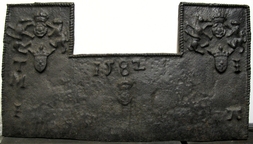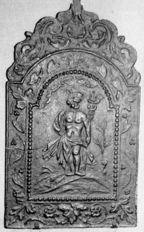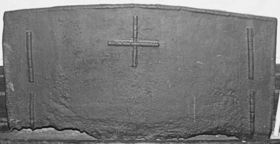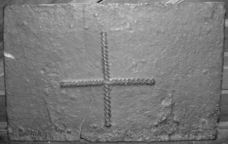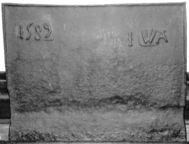-
1243
Description: Canted rectangular shape; twisted rope edging (top and sides); top centre, date '1675'.
Notes: Similar, in size, shape and position of numerals, to a fireback of 1670 but the numerals are from a different stock.
Inscription: 1675
- Decoration tags:
- rectangular with canted top corners (shape)
- rope (edging)
- carved stamps
- individual numbers
- text
Manufactured: in 1675 in England.
Current location: Harvington Hall, Chaddesley Corbett, Worcestershire, England.
(part of the Roman Catholic Archdiocese of Birmingham museum group)
- Attached to series:
- Date only firebacks
-
107
Description: Rectangle with two similar rectangular extensions at top extremities; rope edging (top and sides); on top extensions, two stamps of a dragon and lion supporting a rose and crown, each with a crowned shield bearing a fleur de lys below; central date with rose and crown below; initials TM vertically placed inside middle left edge, initial I middle right; initials I and A, respectively, at lower left and right.
Notes: The initials, TM and I, may relate to a married couple, the first two letters to their first names and the last to their surname; the initials IA are likely to be of the founder as they appear in the same arrangement on other firebacks. The unusual shape would probably have been determined by the structure of the hearth for which it was made; the rose and crown and supporters stamp can also be seen on a large fireback, dated 1593, formerly at Baynard's Park, Surrey (no. 200); the date and IA stamps can be seen, in identical form, on a fireback in the Victoria & Albert Museum, and on two other firebacks, suggesting a common source for all of these firebacks.
Inscription: TM 1582 I / I A
- Decoration tags:
- rectangular with two arches (shape)
- rope (edging)
- carved stamps
- individual letters
- individual numbers
- heraldic
- royal
- text
Manufactured: in 1582 possibly at Pounsley Furnace, Framfield in the Weald area of England.
Current location: Haslemere Educational Museum, Haslemere, Surrey, England.
Museum number: 8582 (part of the Haslemere Educational Museum museum group)
Citation: Anon., 1929, 'An interesting fireback', Sussex Notes and Queries, 2, 8 , p. 242.
- Attached to series:
- 1582 IA series
- Pounsley series
-
108
Description: Quasi-rectangular with narrow arches at top ends and a broad low central arch, between which are flat-topped peaks linked to the arches by shallow concave curves; flanged edge (top and sides); mirroring the edge a channel has been engraved into the metal, extending into the small arches, producing the effect of a wide fillet along the top and sides with an inverted U-shaped return into the end arches; within the channel, at each end, a primitive representation of a vertical, hollow plant stem and four mirrored pairs of curved branches, with a vertical channel parallel to the edge joining the branch ends on the inside; between these is cast a small, rectangular panel with ovolo edging, bearing a full achievement of the arms of the Worshipful Company of Clothworkers; the date is centrally placed above this panel.
Notes: An usual fireback for several reasons: the use of engraving for significant elements of the design, the flanged edge, and the incorporation of a small fireback. The Clothworkers’ arms: Sable a chevron ermine between in chief two Havettes Argent and in base a Teazel Cob Or; crest: on a Mount vert a Ram statant Or; supporters: two Griffins Or pellettée; the arms as displayed were granted in 1587. An example of the armorial fireback on its own is in Petworth House (no. 522).
Inscription: WV 1659 WV
Arms: Worshipful Company of Clothworkers
- Decoration tags:
- rectangular with three arches (shape)
- flanged (edging)
- composite
- individual numbers
- planklines
- armorial
- text
Manufactured: in 1659 in the Weald area of England.
Current location: Haslemere Educational Museum, Haslemere, Surrey, England.
Museum number: 8587 (part of the Haslemere Educational Museum museum group)
- Attached to series:
- Composite firebacks
- Livery company firebacks
-
111
Description: 'Dutch' style; arched rectangular shaped central panel with bead edging, semi-naked figure holding a caduceus in his left hand, standing on a mound with a tree to the right and clouds above; arched rectangular shaped border with fillet edging and an ivy and acanthus leaf pattern; on top an arrangement of swirled foliage.
Notes: The figure is Hermes/Mercury, one of a set of 'Eight Deities' engraved by Hendrick Goltzius (1592), after Polidoro da Caravaggio. Formerly part of the Ade Collection (from Grove Hill, Hellingly, Sussex).
Copies of this fireback are known.
- Decoration tags:
- 'Dutch' (shape)
- fillet (edging)
- whole carved pattern
- mythological
- humans
Manufactured: in the mid- to late-17th century in England.
Current location: Hastings Museum and Art Gallery, John's Place, Bohemia Road, Hastings, East Sussex, England.
Museum number: HASMG: 1952.51.34 (LA 782) (part of the Hastings Museum museum group)
- Attached to series:
- British 'Dutch' style firebacks
- Eight Deities series
-
112
Description: Rectangular with twisted rope edging; straight lengths of rope re-stamped to make longer lengths in the shape of a saltire on each side and a 'V' in the middle.
Notes: The arrangement of the rope lengths may have an apotropaic significance, a double 'v' alluding to the Virgin Mary. Formerly part of the Ade Collection (from Grove Hill, Hellingly, Sussex).
- Decoration tags:
- rectangular (shape)
- rope (edging)
- simple stamps
- apotropaic
- objects
Manufactured: in the mid- to late-16th century in the Weald area of England.
Current location: Hastings Museum and Art Gallery, John's Place, Bohemia Road, Hastings, East Sussex, England.
Museum number: HASMG: 1952.51.20 (part of the Hastings Museum museum group)
- Attached to series:
- Rope design firebacks
-
114
Description: Quasi-rectangular shape with low-curved convex top; edging (top and sides)formed of lengths of dowel grooved laterally and helically; upper centre, cross formed of the same dowel; at each side, tandem arrangement of longer dowel, similarly grooved.
Notes: The base board appears to be the same size and shape as that of a fireback at Plaxtol, Kent (no. 587), which also has the same edging; and the grooved dowels are also on a fireback with dagger stamps at Lewes; the cross will have been intended to have apotropaic significance. Formerly part of the Ade Collection (from Grove Hill, Hellingly, Sussex).
- Decoration tags:
- rectangular (shape)
- grooved dowel (edging)
- simple stamps
- apotropaic
- objects
Manufactured: in the mid- to late-16th century in the Weald area of England.
Current location: Hastings Museum and Art Gallery, John's Place, Bohemia Road, Hastings, East Sussex, England.
Museum number: HASMG: 1952.51.21 (part of the Hastings Museum museum group)
- Attached to series:
- Grooved dowel series
-
115
Description: Plain rectangular plate with cross formed of a single length of twisted rope placed twice.
Notes: Despite the simple form, the likely Christian symbolism is very evident. Formerly part of the Ade Collection (from Grove Hill, Hellingly, Sussex).
- Decoration tags:
- rectangular (shape)
- none (edging)
- simple stamps
- apotropaic
- objects
Manufactured: in the 16th century in the Weald area of England.
Current location: Hastings Museum and Art Gallery, John's Place, Bohemia Road, Hastings, East Sussex, England.
Museum number: HASMG: 1952.51.17 (part of the Hastings Museum museum group)
- Attached to series:
- Rope design firebacks
-
116
Description: Rectangular; twisted rope edging (top and sides); top left, date carved on block; top right, individual letter 'I' followed by 'WA' carved on block.
Notes: The same date stamp appears on a group of multi-facetted, arched firebacks bearing the crowned Tudor arms within a Garter. Formerly part of the Ade Collection (from Grove Hill, Hellingly, Sussex).
Inscription: 1589 I WA
- Decoration tags:
- rectangular (shape)
- rope (edging)
- carved stamps
- date stamp
- text
Manufactured: in 1589 in the Weald area of England.
Current location: Hastings Museum and Art Gallery, John's Place, Bohemia Road, Hastings, East Sussex, England.
Museum number: HASMG: 1952.51.42 (part of the Hastings Museum museum group)
- Attached to series:
- Date & initials firebacks
- 1589 series
-
117
Description: Rectangular with triangular pediment; stepped fillet and ogee moulded edge to pediment; twisted rope sides; date in portico; medallion with dog crest stamped twice in top left and right corners.
Notes: It may be that the date and portico form a separate panel, as the position of the date appears to be the same on the three known castings where it is found.
Inscription: 1586
- Decoration tags:
- triangular arched (shape)
- rope (edging)
- carved stamps
- date stamp
- text
- animals
Manufactured: in 1586 in the Weald area of England.
Current location: Hastings Museum and Art Gallery, John's Place, Bohemia Road, Hastings, East Sussex, England.
Museum number: HASMG: 1917.196.5 (part of the Hastings Museum museum group)
- Attached to series:
- 1586 series
-
118
Description: Rectangular with triangular pediment; stepped fillet and ogee moulded edge; initials in rectangular panel (F reversed); date in portico.
Notes: The triangular top is a separate element, in this instance impressed before the lower panel. A variant at the Victoria and Albert Museum (no. 771) has the letters positioned slightly differently. A version of this fireback, with a rope-edged panel in the lower part, and medallion stamps, can also be seen at Hastings. Formerly part of the Ade Collection (from Grove Hill, Hellingly, Sussex).
Inscription: 1586 F M
- Decoration tags:
- triangular arched (shape)
- stepped fillet and ogee (edging)
- individual letters
- date stamp
- text
Manufactured: in 1586 in the Weald area of England.
Current location: Hastings Museum and Art Gallery, John's Place, Bohemia Road, Hastings, East Sussex, England.
Museum number: HASMG: 1952.51.58 (part of the Hastings Museum museum group)
Citation: Lloyd, N., 1925, 'Domestic Ironwork I', Architectural Review, 58, pp. 58-67.
- Attached to series:
- 1586 series
- Date & initials firebacks

